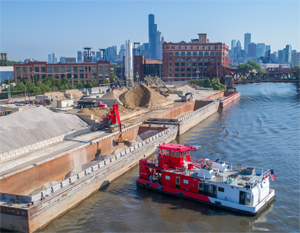Concrete must be discharged from a truck within an hour of being mixed, so reducing the number of fleet vehicles on urban streets increases a supplier’s confidence about timely delivery. Given that context, it’s understandable that Ozinga, a large Chicago-area ready-mix company, elects to transport aggregate and sand by barge, with each barge representing 70 fewer trucks in traffic.
The city’s central business district includes waterways, abbreviated as the Chicago Area Waterway System (CAWS), which allow towboats and barges to keep such commerce flowing. The two newest towboats on CAWS carry the proud red livery of Ozinga, a fourth-generation family business that supplies ready-mix concrete, aggregates and logistics solutions to “Chicagoland” and beyond.
To make better use of the city’s waterways, Ozinga launched Middle River Marine (MRM) in 2008 with a single 26-foot towboat. According to Ed Van Poucke, chief operating officer for Ozinga Materials & Logistics, “MRM was a viable business born of a strategy to better control our supply of aggregates for the ready-mix enterprise, (providing) more vertical integration within the company.”
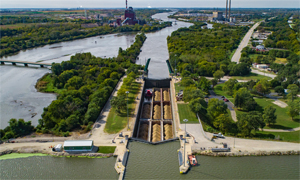 |
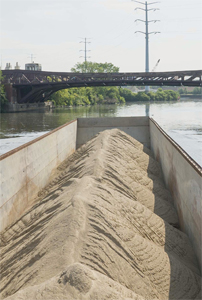 |
|
|
Kamryn Olivia and its eight-barge tow lock through the Brandon Road Lock and Dam on the Des Plaines River in Joliet, Ill. |
A loaded barge guided by Gwyneth Anne heads toward the Ashland Avenue Bridge on the South Branch of the Chicago River. |
In late summer 2018, MRM christened two newbuilds, Gwyneth Anne and Kamryn Olivia, both with retractable wheelhouses and named, as are all MRM vessels, for daughters in the Ozinga family. Although both towboats are “live-aboards,” as Van Poucke describes them — not “lunch-pail boats” or day boats, as he calls the company’s first vessels — the two differ significantly from each other. Both newbuilds are line boats that can push as many as eight barges along the Illinois River. However, near the Loop at Chinatown, site of one of Ozinga’s 10 river terminals, the waterway narrows to such a degree that only one barge at a time can continue up to Northside, another Ozinga terminal on the North Branch of the Chicago River. Gwyneth Anne performs that run. Powered by two Cummins QSK19 Tier 3 engines, the boat is short but beamy at 65 feet by 28 feet, designed specifically for working on this waterway. Its wheelhouse reaches up to 32 feet, yet retracts to 16.5 feet to fit under the lowest non-lift bridge, the Eight-Track Bridge or Scissors Bridges, over the South Branch of the Chicago River.
The larger newbuild, the 80-by-30-foot Kamryn Olivia, is the first towboat in Chicagoland featuring z-drives with Kort nozzles, a decision guided by company efforts to promote fuel savings, efficiency and crew comfort. The two Cummins QSK38 Tier 3 mains provide 2,000 horsepower, allowing Kamryn Olivia to continue working when other boats are windbound. The z-drives also allow the crew to wash debris — a common problem in CAWS — out of a unit by directing thrust into it from the other side of the hull. Kamryn Olivia commonly pushes barges between Chinatown and Peoria, Ill., or ports farther south like Henry, Ill. Crews on both of the newbuilds work three-man, 12-hour shifts on a 21-day rotation.
As with other operators on urban waterways, MRM faces unique challenges. First, the South Branch and Main Stem of the Chicago River have seen explosive growth, with a variety of recreational users sharing the water with commercial vessels, excursion boats and barge traffic. This transformation of CAWS into a leisure area is the result of improved water quality, a change that MRM embraces even though it means towboat and barge operators need to more frequently contend with canoeists, rowers, kayakers, jet skiers and swimmers, many of whom are often unaware of the maneuverability limitations of large commercial vessels.
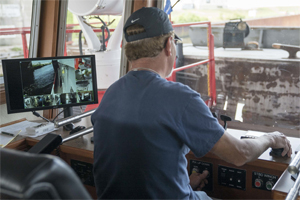 |
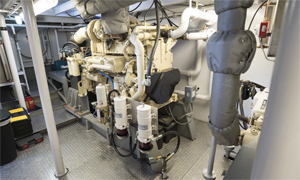 |
|
|
Gwyneth Anne and Kamryn Olivia each have a six-camera pilothouse display to improve visibility on tight, congested waterways. The helmsman is pushing a button to raise the house. |
A pair of Cummins QSK19 main engines provide propulsion on Gwyneth Anne, delivering a combined 1,325 horsepower. |
River conditions also can pose a problem. CAWS operators contend with debris including tires and cars, and ice has become more of an obstacle since the coal-fired Fisk and Crawford power plants were shuttered. When the plants stopped discharging warm water into the waterway, the need for icebreaking increased. “Our boats and crews work on the river even during the 60 to 90 ‘no-pour-concrete days’ here, so the rest of the ice season MRM operations necessitate the extra effort of breaking ice to keep barging,” Van Poucke said. Even when winter conditions prevent ready-mix pours, MRM vessels continue moving cargoes such as aggregate, sand, construction steel, scrap and road salt.
Since MRM operates primarily between Peoria and Chicago, its vessels need to negotiate five of the eight locks between Lake Michigan and the Mississippi River. The challenge here, as with other river infrastructure in the United States, is that much of it is about 100 years old and in need of repair. Last fall, the U.S. Army Corps of Engineers announced scheduled waterway closures of up to 120 days for repairs and upgrades in summer 2020.
Quantifying the contribution of towboat and barge traffic to a greener city, Van Poucke said that one barge carries about 1,500 tons, “the same cargo as more than 70 trucks. If barging were removed from CAWS, 200,000 more trucks per year would be required.” As an example, he cited MRM moving more than 16,500 tons of rubble from a recent demolition on Wacker Drive in the Loop. “Imagine the disruption to Chicago traffic from the (hundreds of) trucks hauling it away,” he said. “Instead, it was transported away in 11 barges, mostly invisible to street and sidewalk traffic.” Ozinga processes rubble into scrap metal and aggregate.
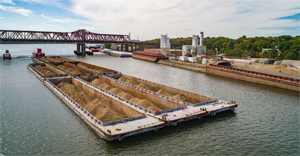 |
|
Kamryn Olivia guides eight barges to Ozinga’s Joliet terminal. Steiner Shipyard of Bayou La Batre, Ala., delivered the 80-foot newbuild in early 2018. Assisting at left is Ozinga’s Elyse Noelle. |
Another recent MRM job entailed moving large structures for Goebel Forming. These forms were so large that barges needed to be ballasted to fit under bridges. Had the forms been moved by roadway, this too would have caused a major disruption to city traffic.
Being a good corporate citizen and promoting a healthy environment fits with Ozinga’s values. In 2011, as a way to reduce fuel costs and curb greenhouse gas emissions, the company purchased its first compressed natural gas (CNG) ready-mix trucks. By 2020, Ozinga plans to have its entire ready-mix fleet fueled by CNG. Creating dispensing stations for its trucks led to the idea of retail sales of CNG. To promote that, Ozinga created an energy division to inform area residents about CNG conversions. The company also recently purchased five electric vehicles, and its two charging stations are open to the public.
In 1984, President Reagan recognized the Illinois & Michigan Canal, part of CAWS, as the first National Heritage Area, of which there are now 55. These areas are intended to highlight efforts in preservation, conservation, recreation and economic development. Ozinga appears to be the kind of company that thrives in such a place.

